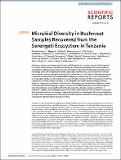| dc.description.abstract | Bushmeat, the meat and organs derived from wildlife species, is a common source of animal protein
in the diets of those living in sub-Saharan Africa and is frequently associated with zoonotic spillover
of dangerous pathogens. Given the frequent consumption of bushmeat in this region and the lack of
knowledge about the microbial communities associated with this meat, the microbiome of 56 fresh
and processed bushmeat samples ascertained from three districts in the Western Serengeti ecosystem
in Tanzania was characterized using 16S rRNA metagenomic sequencing. The results show that the
most abundant phyla present in bushmeat samples include Firmicutes (67.8%), Proteobacteria (18.4%),
Cyanobacteria (8.9%), and Bacteroidetes (3.1%). Regardless of wildlife species, sample condition,
season, or region, the microbiome is diverse across all samples, with no significant difference in alpha
or beta diversity. The findings also suggest the presence of DNA signatures of potentially dangerous
zoonotic pathogens, including those from the genus Bacillus, Brucella, Coxiella, and others, in
bushmeat. Together, this investigation provides a better understanding of the microbiome associated
with this major food source in samples collected from the Western Serengeti in Tanzania and highlights
a need for future investigations on the potential health risks associated with the harvesting, trade, and
consumption of bushmeat in Sub-Saharan Africa | en_US |

